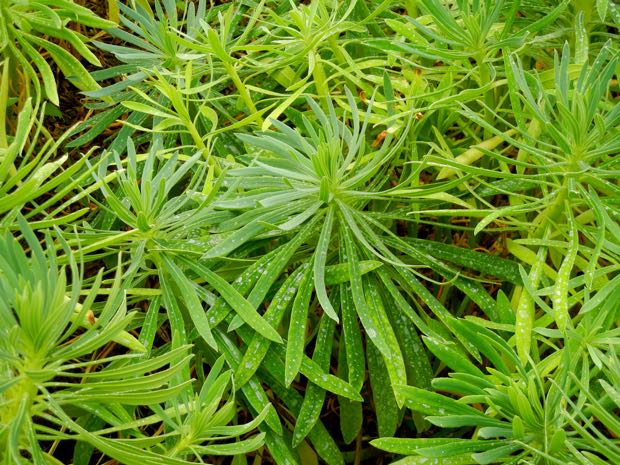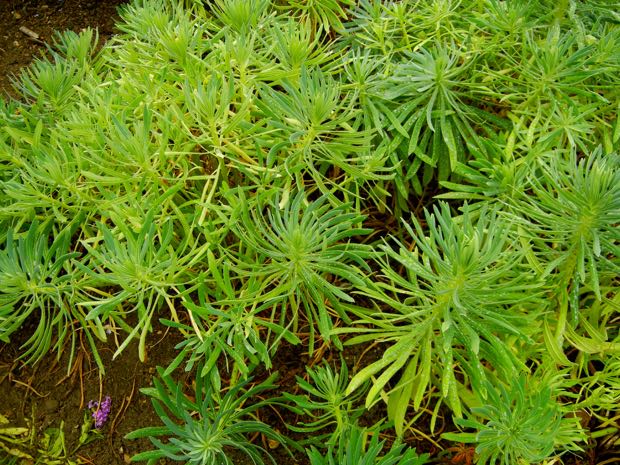Euphorbia characias subsp. wulfenii: The Mediterranean Spurge
Background: Euphorbia characias subsp. wulfenii, commonly known as Euphorbia wulfenii or Mediterranean Spurge, is a captivating sub-shrub that hails from the Mediterranean region. This plant has a rich botanical heritage, with its species belonging to the diverse Euphorbiaceae family, which includes a wide range of flowering plants.
Originating from the sun-drenched landscapes of the Mediterranean, Euphorbia characias subsp. wulfenii has adapted to thrive in arid and rocky environments. Its ability to withstand the harsh conditions of its native habitat has made it a popular choice for gardeners seeking resilient and visually striking plants.
Taxonomy:
The species name “characias” is derived from the Greek word “charax,” which means a stake or a palisade. This name refers to the plant’s erect growth habit and sturdy stems that support its impressive floral display. The subspecies name “wulfenii” pays homage to Franz Xavier von Wulfen, an Austrian botanist who made significant contributions to the study of plant taxonomy and systematics in the 18th century.
Euphorbia characias subsp. wulfenii is often referred to as a biennial, as its flowering branches typically need to be cut back to the ground after blooming. While it may not produce flowers in its first year, the plant develops a robust root system and establishes itself for a spectacular display of blossoms in subsequent years. This biennial growth pattern adds an element of anticipation and reward to the cultivation of Euphorbia characias subsp. wulfenii.
The foliage of Euphorbia characias subsp. wulfenii is characterized by greyish-green leaves that form attractive mounds. These leaves are not only aesthetically pleasing but also contribute to the plant’s ability to conserve moisture in arid conditions. The dome-shaped flowers of this sub-shrub are small and greenish-yellow, appearing in dense clusters that create a captivating visual impact.
Landscaping:
Gardeners and landscape designers appreciate Euphorbia characias subsp. wulfenii for its versatility and ability to adapt to various growing conditions. Its distinctive appearance and adaptability make it a popular choice for Mediterranean-style gardens, rockeries, and coastal landscapes, where it thrives in full sun and well-drained soils.
Whether used as a focal point in a flower bed, a border plant, or a component of a xeriscaped garden, Euphorbia characias subsp. wulfenii brings a touch of Mediterranean charm and resilience to any landscape. Its combination of architectural foliage and vibrant flowers creates a visually dynamic presence that can enhance the beauty of both formal and informal garden designs. By understanding and respecting the natural characteristics of this remarkable sub-shrub, gardeners can harness its inherent beauty and enjoy its enduring allure in their outdoor spaces.
Cultivation of Euphorbia characias subsp. wulfenii:
Planting: To ensure optimal growth, plant Euphorbia characias subsp. wulfenii in a location that receives full sun. It thrives in well-drained soil that is moist but not waterlogged. Prepare the planting area by loosening the soil and removing any weeds or debris. Dig a hole slightly larger than the plant’s root ball and gently place the plant in the hole. Backfill with soil, firming it gently around the base of the plant.
Watering: During the first year after planting, water Euphorbia characias subsp. wulfenii regularly to help establish its root system. Once the plant is established, it becomes drought-tolerant and requires less frequent watering. Monitor the soil moisture levels and water when the top inch of soil feels dry. Avoid overwatering, as excessive moisture can lead to root rot.
Fertilizer: In the spring, apply a balanced fertilizer to Euphorbia characias subsp. wulfenii to provide it with necessary nutrients. Use a slow-release fertilizer according to the package instructions. Avoid over-fertilization, as this can cause excessive leaf growth at the expense of flower production.
Cutting Back: After the flowering period, it is recommended to cut back the stems of Euphorbia characias subsp. wulfenii to the ground. This practice helps to rejuvenate the plant and promote new growth in the following spring. Use clean and sharp pruners to make clean cuts just above the ground level.
Pests and Diseases:
Euphorbia characias subsp. wulfenii is generally a relatively pest-free plant. However, it can occasionally be susceptible to aphids and scale insects. If you notice any pests on your plant, you can treat them with insecticidal soap or neem oil, following the instructions on the product label. Another common issue is powdery mildew, a fungal disease that causes white spots on the leaves. To prevent powdery mildew, ensure adequate air circulation around the plant and avoid overhead watering. If you observe signs of powdery mildew, apply a fungicide specifically formulated for controlling this disease.
With its unique appearance and adaptability, Euphorbia characias subsp. wulfenii is a wonderful addition to gardens, providing year-round interest and resilience. Ensure proper care and maintenance, and this Mediterranean Spurge will thrive and bring beauty to your landscape.





